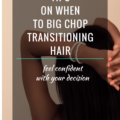For anyone who is or has transitioned to natural hair, what I am about to share with you won’t come up as a surprise. I know that many of you out there are going through this same issue and many are taken over the edge and give up altogether. The struggles are many and I mentioned them briefly on 8 Signs You’re Having A Natural Hair Meltdown And How To Stay Motivated, but what I didn’t talk about in that post were the transitioning struggles of having two hair textures.
Transitioning is not easy, it really isn’t! People may think “Oh, you still keep your length”, but honestly doing a BC (big chop) looks a lot easier to deal with than the bipolar personalities of two different hair textures, that never seem to have an episode at the same time, ’cause that way, at least, they could both receive the same treatment. But let’s just talk about what these struggles are and how they can be addressed.
TRANSITIONING STRUGGLES
1| THICK & THIN HAIR
Having two textures means you have thick hair at the roots and thin hair at the ends that look limp and dead. It’s like carrying dead weight on your head all day all the time. The worst thing about it, or should I say the frightening thing about it, is that it looks so fragile that you may lose it at any moment.
Solution: One way you can solve this is to blend both textures, and you can do this by doing braid outs, twist outs, bantu knots. You can also use a few different hair tools such as perm rods or flexi rods. Read 6 Ways To Blend Transitioning Hair.
2| BREAKAGE
Breakage should probably be named first on this list since it’s the one thing people complain more about. One false move, too much manipulation or a hairband too tight and Bang! a few more hair strands are gone. Let me tell you that breakage is a constant forecast in this journey!
There’s a natural explanation for this, and it’s connected to the previous struggle on this list. Your natural hair is much stronger and thicker than your relaxed thin hair, and the place where both meet, the line of demarcation, is the place where breakage happens most often.
Solution: Favour protective or low manipulation hairstyles as these minimise stress and, consequently, lessen breakage on your hair. Don’t forget to regularly deep conditioning for moisture and protein to strengthen and trim your hair every 3 to 4 months.
3| DIFFERENT HAIR LENGTHS
It is quite possible that if you’re on this journey and you are experiencing heavy breakage that you have different hair lengths. It really does seem like fate is playing a joke on you. How are you supposed to maintain some dignity with your hair looking like that? For real, right!? It’s not like you’re going for the mad scientist look.
Yeah, having different hair lengths is a big possibility if you suffer massively with struggle number two, breakage. You gotta be gentle and take care of that line of demarcation, is the breaking point between the two hair textures and since one is weaker than the other we all know the outcome.
Solution: To disguise or hide your hair length you can decide to keep your hair in protective styles such as braids or twists or use hair extensions. Do the latter for periods of 4 to 6 weeks, let your hair and scalp rest for two weeks and redo them again until you feel comfortable with your hair length.
4| DETANGLING
When you transition from relaxed to natural hair and as your hair grows, detangling your hair can sometimes turn into a tug of war. Really, I’m not exaggerating I remember how that was for me. I was so used to the easy process of detangling straight relaxed hair that my natural hair came as a shock.
The catch was, I had to be very careful when detangling, cause being too brisk meant (1) risking heavy breakage at the line of demarcation, (2) having different hair lengths and (3) a look I wouldn’t be able to manage since I didn’t want to use any extensions.
Solution: One of the best thing you can do to overcome the struggling difficulties of detangling is to keep your hair in protective styles for as long as possible as this minimises tangles and knots (don’t go over the 7-10 day mark). Secondly, you can do an oil pre-poo before you wash your hair as it eases the detangling process (one of its many benefits), you should also divide your hair into sections and, most importantly, use your fingers to detangle your hair or a wide-tooth comb. This allows you to feels any tangles and not force them through causing more tangles and breakage.
5| MOISTURE
Moisture is the most recurring problem natural hair transitioners and naturals have. If you want healthy growing hair you need to not only nurture and shield it from external “aggressions”, but you also need to have it moisturised at all times. I know this is something you may feel is easier said than done, especially when you have two different hair textures with different needs. Talk about an impossible mission, right?!
Well, it’s not so impossible. With some effort and knowledge of your hair, you can have your hair moisturised at all times.
Solution: A big secret to having your hair moisturised at all times is to shampoo it. This removes product buildup and allows water in. Another solution is to use products that have humectants in it, such as glycerin, honey or aloe vera. Of course, you should also avoid products that have ingredients that take the moisture off your hair. Finally, make every effort to know your hair so you know how to moisturise it no matter what.
There are, of course, other transitioning hair struggles we face in our journey to natural hair, but these seem to be the most frequent ones. What other struggles do you face and how do you overcome your struggles? Whatever you face in your journey remember:
“Don’t stress. Do your very best and appreciate each step you take.”







